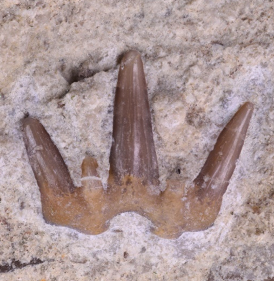First records of the chondrichthyans Heslerodus and Ossianodus from the Upper Pennsylvanian LaSalle Limestone (Bond Formation) of northern Illinois
DOI:
https://doi.org/10.21900/j.kentiana.n.1439Keywords:
Heslerodus, Ossianodus, Chondrichthyes, Elasmobranchii, sharks, LaSalle CountyAbstract
Heslerodus divergens and an undetermined species of the genus Ossianodus are recorded for the first time from the Upper Pennsylvanian LaSalle Limestone Member of the Bond Formation in northern Illinois. Ossianodus is a new record for the state. Four specimens of H. divergens and one of Ossianodus sp. were recovered, all partially complete teeth. Descriptive and comparative notes are provided. Future studies of the formation may yield additional specimens of other vertebrate species.
References
Bonaparte, C.L. 1838. Synopsis vertebratorum systematis. Nuovi Annali della Scienze Naturali, Bologna 11: 105–133.
Brusatte, S.L. 2007. Pennsylvanian (Late Carboniferous) chondrichthyans from the LaSalle Limestone Member (Bond Formation) of Illinois, USA. Neues Jahrbuch für Geologie und Paläontologie – Abhandlungen 244: 1–8.
Cline, D.A. 2022. Vertebrate assemblages of the Skelley Limestone (Conemaugh Group: Carboniferous, Gzhelian) in Noble and Muskingum Counties, Ohio. M.S. Thesis, Wright State University, Dayton, Ohio, 78 pp.
Ginter, M. 2002. Taxonomic notes on “Phoebodus heslerorum” and Symmorium reniforme (Chondrichthyes, Elasmobranchii). Acta Palaeontologica Polonica 47: 547–555.
Ginter, M. 2016. The heterodonty in euselachian sharks from the Pennsylvanian of Nebraska. Acta Geologica Polonica 66: 299–312.
Ginter, M., Hampe, O. & Duffin, C. 2010. Chondrichthyes: Paleozoic Elasmobranchii: Teeth. Handbook of Palaeoichthyology, Volume 3D. Dr. Friedrich Pfeil Publishers, Munich, Germany, 168 pp.
Glikman, L.S. 1964. Sharks of the Paleogene and their stratigraphic significance. Nauka Press, Moscow, Soviet Union (in Russian), 229 pp.
Hatch, J.R. & Affolter, R.H. 2002. Resource assessment of the Springfield, Herrin, Danville, and Baker coals in the Illinois Basin. U.S. Geological Survey Professional Paper 1625-D: 1–230.
Huxley, T.H. 1880. On the application of the laws of evolution to the arrangement of the Vertebrata and more, particularly the Mammalia. Proceedings of the Zoological Society of London 1880: 649–662.
Hodnett, J.P.M., Tweet, J.S. & Santucci, V.L. 2022. The occurrence of fossil cartilaginous fishes (Chondrichthyes) within the parks and monuments of the National Parks Service. New Mexico Museum of Natural History and Science Bulletin 90: 183–208.
Maisey, J. 2010. Heslerodidae (Chondrichthyes, Elasmobranchii), a new family of Paleozoic phalacan-thous sharks. Kirtlandia 57: 13–21.
Ossian, C. 1974. Paleontology, paleobotany and facies characteristics of a Pennsylvanian delta in southeastern Nebraska. Ph.D. Thesis, University of Texas, Austin, Texas, 393 pp.
Owen, R. 1846. Lectures on the comparative anatomy and physiology of the vertebrate animals, delivered at the Royal College of Surgeons of England in 1844 and 1846. Part 1. Fishes. Longman, London, UK, 308 pp.
Patterson, C. 1966. British Wealden sharks. Bulletin of the British Museum (Natural History) 11: 283–350.
Trautschold, H. 1879. Die Kalchbrüche von Mjatschkowa. Eine Monographie des oberen Bergkalks. Nouveau Mémoires de la Société Impérial des Naturalistes de Moscou 14: 3–82.
Williams, M.E. 1985. The “cladodont level” sharks of the Pennsylvanian black shales of North America. Palaeontographica 190: 83–158.
Published
Issue
Section
License
Copyright (c) 2023 Ricky Gieser, Ryan Shell, M. Jared Thomas, Mark Davis

This work is licensed under a Creative Commons Attribution 4.0 International License.



